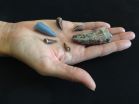(Press-News.org) DARIEN, IL – Public health and safety are threatened by the increasing prevalence of obstructive sleep apnea, which now afflicts at least 25 million adults in the U.S., according to the National Healthy Sleep Awareness Project. Several new studies highlight the destructive nature of obstructive sleep apnea, a chronic disease that increases the risk of high blood pressure, heart disease, Type 2 diabetes, stroke and depression.
"Obstructive sleep apnea is destroying the health of millions of Americans, and the problem has only gotten worse over the last two decades," said American Academy of Sleep Medicine President Dr. Timothy Morgenthaler, a national spokesperson for the Healthy Sleep Project. "The effective treatment of sleep apnea is one of the keys to success as our nation attempts to reduce health care spending and improve chronic disease management."
Data previously published in the American Journal of Epidemiology show that the estimated prevalence rates of obstructive sleep apnea have increased substantially over the last two decades, most likely due to the obesity epidemic. It is now estimated that 26 percent of adults between the ages of 30 and 70 years have sleep apnea.
Findings from new studies emphasize the negative effects of sleep apnea on brain and heart health; however, these health risks can be reduced through the effective treatment of sleep apnea with continuous positive airway pressure therapy:
A neuroimaging study in the September issue of the journal Sleep found that participants with severe, untreated sleep apnea had a significant reduction in white matter fiber integrity in multiple brain areas, which was accompanied by impairments to cognition, mood and daytime alertness. One year of CPAP therapy led to an almost complete reversal of this brain damage.
A study published online ahead of print Sept. 21 in the journal NeuroImage found functional and anatomical changes in brainstem regions of people with sleep apnea.
A study in the October issue of Anesthesiology shows that diagnosing sleep apnea and prescribing CPAP therapy prior to surgery significantly reduced postoperative cardiovascular complications - specifically cardiac arrest and shock - by more than half.
A study published online ahead of print Sept. 19 in the Journal of Hypertension found a favorable reduction of blood pressure with CPAP treatment in patients with resistant hypertension and sleep apnea.
A Brazilian population study published online ahead of print Sept. 23 found that nocturnal cardiac arrhythmias occurred in 92 percent of patients with severe sleep apnea, compared with 53 percent of people without sleep apnea. The prevalence of rhythm disturbance also increased with sleep apnea severity.
Common warning signs for sleep apnea include snoring and choking, gasping, or silent breathing pauses during sleep. The American Academy of Sleep Medicine, Centers for Disease Control and Prevention, Sleep Research Society and other partners in the National Healthy Sleep Awareness Project urge anyone with signs or symptoms of sleep apnea to visit http://www.stopsnoringpledge.org to pledge to "Stop the Snore" and talk to a doctor about sleep apnea.
INFORMATION:
References
Peppard PE, Young T, Barnet JH, et al. Increased prevalence of sleep-disordered breathing in adults. Am J Epidemiol 2013 May 1;177(9):1006-14. Epub 2013 Apr 14.
Castronovo V, Scifo P, Castellano A, et al. White matter integrity in obstructive sleep apnea before and after treatment. SLEEP 2014;37(9):1465-1475.
Lundblad LC, Fatouleh RH, Hammam E, et al. Brainstem changes associated with increased muscle sympathetic drive in obstructive sleep apnea. Neuroimage 2014 Sep 21 [Epub ahead of print].
Mutter TC, Chateau D, Moffatt M, et al. A matched cohort study of postoperative outcomes in obstructive sleep apnea: could preoperative diagnosis and treatment prevent complications? Anesthesiology. 2014 Oct;121(4):707-18.
Iftikhar IH, Valentine CW, Bittencourt LR, et al. Effects of continuous positive airway pressure on blood pressure in patients with resistant hypertension and obstructive sleep apnea: a meta-analysis. J Hypertens 2014 Sep 19 [Epub ahead of print].
Cintra FD, Leite RP, Storti LJ, et al. Sleep Apnea and Nocturnal Cardiac Arrhythmia: A Populational Study. Arq Bras Cardiol 2014 Sep 23 [Epub ahead of print].
About the National Healthy Sleep Awareness Project
The Healthy Sleep Project addresses the sleep health focus area of Healthy People 2020, which provides science-based, 10-year national objectives for improving the health of all Americans. The sleep health objectives are to increase the medical evaluation of people with symptoms of obstructive sleep apnea, reduce vehicular crashes due to drowsy driving and ensure more Americans get sufficient sleep. For more information, visit http://www.projecthealthysleep.org
Rising prevalence of sleep apnea in US threatens public health
New studies highlight destructive nature of obstructive sleep apnea and benefits of CPAP therapy
2014-09-29
ELSE PRESS RELEASES FROM THIS DATE:
Targeted combination therapy halts disease, extends life in advanced melanoma patients
2014-09-29
A world-first study in today's New England Journal of Medicine heralds the efficacy of a targeted combination drug therapy after reporting major declines in the risk of disease progression and death in people with metastatic melanoma.
The multi-centre, double-blind, randomised, phase 3 trial compared oral dabrafenib (150 mg twice daily) and oral trametinib (2 mg once daily) combination therapy with oral dabrafenib (150 mg twice daily) and placebo.
All trial patients had inoperable stage 3C or 4 metastatic melanoma that had a BRAF gene mutation V600E or V600K. Among ...
Investigating the 'underground' habitat of Listeria bacteria
2014-09-29
The literature describes Listeria as ubiquitous bacteria with widespread occurrence. Yet they only become a problem for humans and animals when they contaminate food processing facilities, multiply, and enter the food chain in high concentrations. An infection with Listeria monocytogenes can even be fatal for humans or animals with weakened immune systems.
Listeria in soil or water are not dangerous
"Listeria in soil or water represent a relatively low risk to humans," explains study director Beatrix Stessl. "The concentrations are too low. The aim of our study was ...
Trial shows trastuzumab should remain as standard of care for HER2-positive breast cancer
2014-09-29
JACKSONVILLE, Fla., Sept. 29, 2014 — Analysis of more than 8,000 women who participated in the world's largest study of two treatments for HER2-positive breast cancer reinforces other findings from the clinical trial showing that trastuzumab (Herceptin) should remain the standard of care for this cancer, says a Mayo Clinic researcher.
This study, being presented at the European Society for Medical Oncology (ESMO) 2014 Congress in Madrid, reveals that when used as a single HER2-targeted therapy in addition to standard chemotherapy, trastuzumab offers a better outcome than ...
Tooth serves as evidence of 220 million-year-old attack
2014-09-29
At the beginning of the age of dinosaurs, gigantic reptiles—distant relatives of modern crocodiles—ruled the earth. Some lived on land and others in water and it was thought they didn't much interact. But a tooth found by a University of Tennessee, Knoxville, researcher in the thigh of one of these ancient animals is challenging this belief.
Stephanie Drumheller, an earth and planetary sciences lecturer, and her Virginia Tech colleagues Michelle Stocker and Sterling Nesbitt examined 220-million-year-old bite marks in the thigh bones of an old reptile and found evidence ...
A molecular mechanism involved in cellular proliferation characterized
2014-09-29
Researchers from Guillermo Montoya's team at the Spanish National Cancer Research Centre (CNIO), in collaboration with Isabelle Vernos' Group from the Centre for Genomic Regulation (CRG), have uncovered the molecular interaction between TACC3 and chTOG, key proteins in forming the internal cellular framework that enables and sustains cell division. Published today in Nature Communications, the observations may help to optimise current oncological therapies specifically designed to fight against this framework, named by the scientific community as microtubules.
KEY MOLECULES ...
New method to motivate students to reduce energy consumption
2014-09-29
The research found that a combination of a real-time feedback system together with a human energy delegate in eight halls of residence resulted in a reduction of 37% in energy consumption when compared to normal consumption. The savings were 1360.49 kWh, which is equivalent to a reduction of 713.71 kg of CO2 over four weeks.
In contrast, another eight halls, exposed only to the real-time feedback and a weekly email alert, resulted in saw a 3.5% reduction in energy consumption.
Student's energy-use behaviour is complex as they cannot easily identify how much electricity ...
Dolphins are attracted to magnets
2014-09-29
Dolphins are indeed sensitive to magnetic stimuli, as they behave differently when swimming near magnetized objects. So says Dorothee Kremers and her colleagues at Ethos unit of the Université de Rennes in France, in a study in Springer's journal Naturwissenschaften – The Science of Nature. Their research, conducted in the delphinarium of Planète Sauvage in France, provides experimental behavioral proof that these marine animals are magnetoreceptive.
Magnetoreception implies the ability to perceive a magnetic field. It is supposed to play an important role in how some ...
Human trafficking, an invisible problem
2014-09-29
This news release is available in Spanish. This study compares the existing legislation on this subject in European countries and analyzes both the level of protection afforded to the victims and the measures taken to avoid this crime; in addition, it proposes of code of best practices that favors the enactment of new European guidelines aimed at ending this activity. Specifically, it shows that one of the first obstacles to change is that the magnitude of the problem is not known, points out one of the authors of the report, Begoña Marugán Pintos, of the department ...
Evolutionary biology: It's not just for textbooks anymore
2014-09-29
Solving global challenges in food security, emerging diseases and biodiversity loss requires evolutionary thinking, argues a new study published online in Science Express that was co-authored by Bruce Tabashnik of the University of Arizona College of Agriculture and Life Sciences.
For the first time, an international team of nine scientists has reviewed progress in addressing a broad set of challenges in agriculture, medicine and environmental management using approaches that consider evolutionary histories and the likelihood of rapid adaptation to human activities.
The ...
IMPRESS trial data on continuing tyrosine kinase inhibitor therapy after resistance development in lung cancer reported
2014-09-29
Patients whose lung cancer has developed resistance to the drug gefitinib experience no statistically significant improvement in progression-free survival from continued treatment with the drug in addition to chemotherapy, a phase III trial presented at the ESMO 2014 Congress has shown.
The IMPRESS trial is a randomised phase III study that compared continuation of gefitinib in addition to chemotherapy against chemotherapy alone in patients with lung cancer that carried mutations in the EGFR cell surface receptor.
Gefitinib is a type of drug known as a tyrosine kinase ...
LAST 30 PRESS RELEASES:
Tracing the quick synthesis of an industrially important catalyst
New software sheds light on cancer’s hidden genetic networks
UT Health San Antonio awarded $3 million in CPRIT grants to bolster cancer research and prevention efforts in South Texas
Third symposium spotlights global challenge of new contaminants in China’s fight against pollution
From straw to soil harmony: International team reveals how biochar supercharges carbon-smart farming
Myeloma: How AI is redrawing the map of cancer care
Manhattan E. Charurat, Ph.D., MHS invested as the Homer and Martha Gudelsky Distinguished Professor in Medicine at the University of Maryland School of Medicine
Insilico Medicine’s Pharma.AI Q4 Winter Launch Recap: Revolutionizing drug discovery with cutting-edge AI innovations, accelerating the path to pharmaceutical superintelligence
Nanoplastics have diet-dependent impacts on digestive system health
Brain neuron death occurs throughout life and increases with age, a natural human protein drug may halt neuron death in Alzheimer’s disease
SPIE and CLP announce the recipients of the 2025 Advanced Photonics Young Innovator Award
Lessons from the Caldor Fire’s Christmas Valley ‘Miracle’
Ant societies rose by trading individual protection for collective power
Research reveals how ancient viral DNA shapes early embryonic development
A molecular gatekeeper that controls protein synthesis
New ‘cloaking device’ concept to shield sensitive tech from magnetic fields
Researchers show impact of mountain building and climate change on alpine biodiversity
Study models the transition from Neanderthals to modern humans in Europe
University of Phoenix College of Doctoral Studies releases white paper on AI-driven skilling to reduce burnout and restore worker autonomy
AIs fail at the game of visual “telephone”
The levers for a sustainable food system
Potential changes in US homelessness by ending federal support for housing first programs
Vulnerability of large language models to prompt injection when providing medical advice
Researchers develop new system for high-energy-density, long-life, multi-electron transfer bromine-based flow batteries
Ending federal support for housing first programs could increase U.S. homelessness by 5% in one year, new JAMA study finds
New research uncovers molecular ‘safety switch’ shielding cancers from immune attack
Bacteria resisting viral infection can still sink carbon to ocean floor
Younger biological age may increase depression risk in older women during COVID-19
Bharat Innovates 2026 National Basecamp Showcases India’s Most Promising Deep-Tech Ventures
Here’s what determines whether your income level rises or falls
[Press-News.org] Rising prevalence of sleep apnea in US threatens public healthNew studies highlight destructive nature of obstructive sleep apnea and benefits of CPAP therapy




